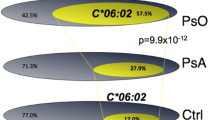Abstract
The purpose of this study is to examine the genetic interaction of variably expressed killer cell immunoglobulin-like receptor (KIR) 3DL1 alleles with their cognate ligand, human leukocyte antigen (HLA)-Bw4, in susceptibility to psoriatic disease (PsD). A novel allelic typing system was developed to differentiate KIR3DL1 alleles (*High, *Low, *Null expression, and 3DS1), in PsD patients, including those with psoriatic arthritis (PsA) and cutaneous psoriasis without arthritis (PsC) and healthy controls. Frequencies of each KIR3DL1 allele, Bw4-80I and Bw4-80T, as well as the genetic interaction between the KIR3DL1 alleles and the Bw4 epitope were analyzed. KIR3DL1 alleles were successfully genotyped in 392 PsA, 260 PsC, and 371 control subjects. Only the KIR3DL1*Null allele was associated with PsD (OR = 0.69, p = 0.008), both in the PsA (OR = 0.69, p = 0.02) and PsC patients (OR = 0.70, p = 0.04) compared to control subjects. No difference in the frequency of KIR3DL1*Null was found between the PsA and PsC patients. The presence of the HLA-Bw4 epitope was significantly associated with PsD, particularly in the PsA patients compared to controls. Bw4-80I was increased in PsD and PsA subjects, but not in PsC patients compared to controls. Bw4-80T was increased in PsA compared to both PsC patients or to controls. No interaction was detected between any of the KIR3DL1 alleles and HLA-Bw4, Bw4-80I, or Bw4-80T. The novel qPCR technique successfully identified the four variably expressed KIR3DL1 alleles. The HLA-Bw4 epitope was associated with psoriatic disease, particularly with PsA, but no genetic interactions with KIR3DL1 alleles were detected.
Similar content being viewed by others
References
Chandran V, Raychaudhuri SP (2010) Geoepidemiology and environmental factors of psoriasis and psoriatic arthritis. J Autoimmun 34:J314–J321
Gladman DD, Antoni C, Mease P et al (2005) Psoriatic arthritis: epidemiology, clinical features, course, and outcome. Ann rheum dis 64(Suppl 2):ii14–ii17
Spadaro A, Scrivo R, Moretti T et al (2004) Natural killer cells and gamma/delta T cells in synovial fluid and in peripheral blood of patients with psoriatic arthritis. Clin Exp Rheumatol 22:389–394
Vivier E, Nunes JA, Vely F (2004) Natural killer cell signaling pathways. Science 306:1517–1519
Khakoo SI, Carrington M (2006) KIR and disease: a model system or system of models? Immunol Rev 214:186–201
Martin MP, Nelson G, Lee JH et al (2002) Cutting edge: susceptibility to psoriatic arthritis: influence of activating killer Ig-like receptor genes in the absence of specific HLA-C alleles. J Immunol 169:2818–2822
Boulet S, Kleyman M, Kim JY et al (2008) A combined genotype of KIR3DL1 high expressing alleles and HLA-B*57 is associated with a reduced risk of HIV infection. AIDS 31:1487–1491
Gardiner CM, Guethlein LA, Shilling HG et al (2001) Different NK cell surface phenotypes defined by the DX9 antibody are due to KIR3DL1 gene polymorphism. J Immunol 166:2992–3001
Taner SB, Pando MJ, Roberts A et al (2011) Interactions of NK cell receptor KIR3DL1*004 with chaperones and conformation-specific antibody reveal a functional folded state as well as predominant intracellular retention. J Immunol 186:62–72
Cella M, Longo A, Ferrara GB, Strominger JL, Colonna M (1994) NK3-specific natural killer cells are selectively inhibited by Bw4-positive HLA alleles with isoleucine 80. J Exp Med 180:1235–1242
Gladman DD, Anhorn KA, Schachter RK, Mervart H (1986) HLA antigens in psoriatic arthritis. J Rheumatol 13:586–592
Eder L, Chandran V, Pellett F et al (2012) Human leucocyte antigen risk alleles for psoriatic arthritis among patients with psoriasis. Ann Rheum Dis 71:50–55
Chandran V, Bull SB, Pellett FJ et al (2014) Killer cell immunoglobulin-like receptor gene polymorphisms and susceptibility to psoriatic arthritis. Rheumatology (Oxford) 53:233–239
Kulkarni S, Martin MP, Carrington M (2008) The yin and yang of HLA and KIR in human disease. Semin Immunol 20:343–352
TajikN SF, Poormoghim H et al (2011) KIR3DL1+HLA-B Bw4Ile80 and KIR2DS1+HLA-C2 combinations are both associated with ankylosing spondylitis in the Iranian population. Int J Immunogenet 38:403–409
Diaz-Pena R, Blanco-Gelaz MA, Suarez-Akvarez B et al (2008) Activating KIR genes are associated with ankylosing spondylitis in Asian populations. Hum Immunol 69:437–442
Lopez-Larrea C, Blanco-Gelaz MA, Torre-Alonso JC et al (2006) Contribution of KIR3DL1/3DS1 to ankylosing spondylitis in human leukocyte antigen-B27 Caucasian populations. Arthritis Res Ther 8:R101
McCappin J, Harvey D, Wordsworth BP, Middleton D (2009) No association of KIR3LD1 or KIR3DS1 or their alleles with ankylosing spondylitis. Tissue Antigens 75:68–73
Chen H, Hayashi G, Lai OY et al (2012) Psoriasis patients are enriched for genetic variants that protect against HIV-1 disease. PLoS Genet 8:e1002514
Augusto DG, Lobo-Alves SC, Melo MF et al (2012) Activating KIR and HLA Bw4 ligands are associated to decreased susceptibility to pemphigus foliaceus, an autoimmune blistering skin disease. PLoS One 7:e39991
Ahn RS, Moslehi H, Martin MP et al (2016) Inhibitory KIR3DL1 alleles are associated with psoriasis. Br J Dermatol 174:449–451
Diaz-Pena R, Vidal-Castineira JR, Alonso-Arias R et al (2010) Association of the KIR3DS1*013 and KIR3DL1*004 alleles with susceptibility to ankylosing spondylitis. Arthritis Rheum 62:1000–1006
Pollock RA, Pellett FJ, Chandran V, Gladman DD (2011) Expression patterns of natural killer receptor genes in inflamed joints and peripheral blood of patients with psoriatic arthritis. Tissue Antigens 78:345–347
Acknowledgments
The PsA clinic is supported by a grant from the Krembil Foundation. Jeffrey Berinstein was supported by the Canadian Institutes of Health Research (CIHR) and Institute of Musculoskeletal Health and Arthritis (IMHA) summer studentship. Remy Pollock was supported by a CIHR Banting and Best Canada Graduate Scholarship Doctoral Research Award.
Author information
Authors and Affiliations
Corresponding author
Ethics declarations
Disclosures
None
Electronic supplementary material
ESM 1
(DOCX 18kb)
Rights and permissions
About this article
Cite this article
Berinstein, J., Pollock, R., Pellett, F. et al. Association of variably expressed KIR3dl1 alleles with psoriatic disease. Clin Rheumatol 36, 2261–2266 (2017). https://doi.org/10.1007/s10067-017-3784-5
Received:
Revised:
Accepted:
Published:
Issue Date:
DOI: https://doi.org/10.1007/s10067-017-3784-5




